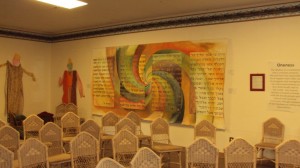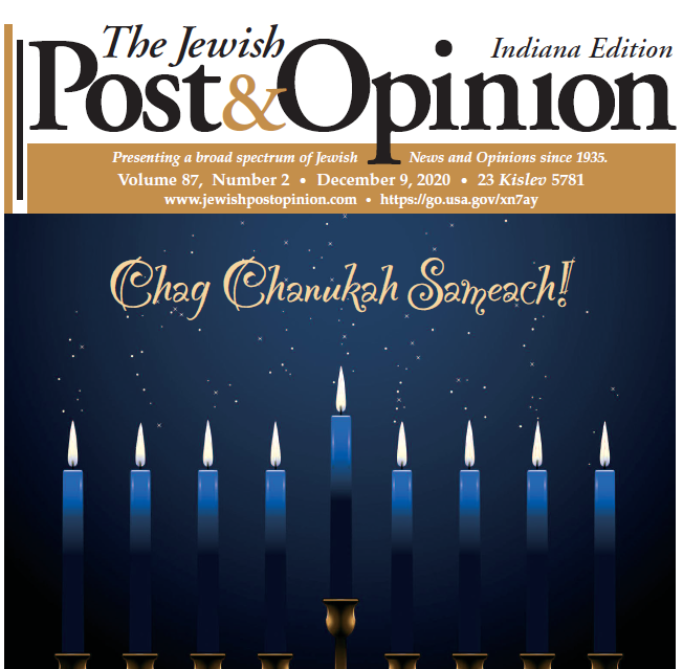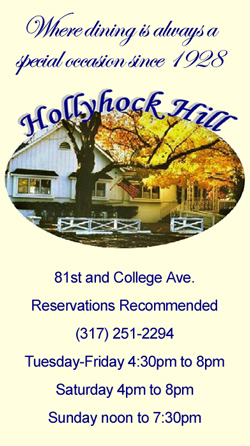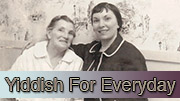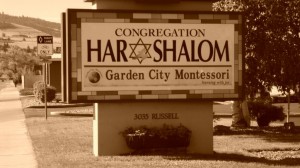
In the background one can see some of the mountains that surround the city.
Fountain of Judaism flows in the mountain of peace
By Matthew J. Silver
When I first contacted members of the Har Shalom Congregation in Missoula, Mont., in 2003, they were holding services, Sunday school and meetings in the public library, sometimes in a church and other times in members’ homes. An Orthodox-trained rabbi came from Santa Fe, N.M., for services and b’nai mitzvah when requested, but his leadership, which he termed “flexidoxy,” sprang from a mix of Orthodox Judaism, eastern mysticism, the Kabbalah, Indian drumming and humor.
Some, perhaps the younger congregants from the University of Montana, saw it as a fresh alternative to traditional Judaism. Some said “magical,” some said “mishigos.” I had spoken with Susan Hay, Scott Green and Jim Gray. Green the dentist liked the rabbi, who conducted his son’s bar mitzvah; Gray the chef drove three hours to Butte for High Holy Days services; Susan, the non-profit director, not terribly fond of the rabbi, celebrated Shabbos with friends every Friday night.
Termed the Garden City, Missoula is on the Lewis & Clark Trail, the home of nearly 60,000 people plus 12,000 students at the University of Montana. Originally founded as a logging area and trading post to service Native Americans, ranchers, miners and farmers, is scenically stunning, nestled in a valley in the Bitterroot Mountain range, some with ice caps in summer.
In August 2009 the story began, as the congregation finally moved into its own building, achieving a long term goal: “Now some Brotherhood meetings start with a prayer, talk of what happened at their last meeting maybe, who is ushering when, who didn’t when he was supposed to, discussion of the children sponsored at JCC day camp, how much Irving paid for an aliyah, and how much Irving should have paid. Then they start talking about someone’s brother-in-law’s money and members get mad and everybody goes home.
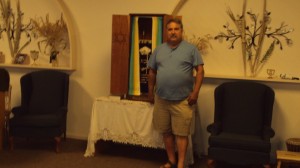
Bert Chessin stands with the Ark at Har Shalom.
In Missoula the men of Congregation Har Shalom gather in the middle of the Clark Fork River that roars through downtown to fly fish. That’s their venue. Some call it the Tallis, Tefillin and Tackle Club. “Our gatherings are in the river in wading boots, instead of in some committee room at the shul,” said congregation president Bert Chessin. “These brotherhood ties are to fishing lines,” he laughed. Soothing waters. Born and raised here, and recently returned, his favorite bar mitzvah gift was a fly rod.
Toba Winston was president at the time of the acquisition of the building, and was instrumental in securing the original loan and obtaining initial guarantors. She shepherded through the affiliation with the Union for Reform Judaism, as well the accompanying dismissal by the congregation of the contract rabbi from Santa Fe.
“He had been here for quite a few years, and many people liked him, especially the younger set. But I felt for the congregation to grow, we needed affiliation,” she noted. Winston, who moved to Missoula from Baltimore in 1999, credits Rabbi David Fine of Seattle with being extremely helpful all along the way.
In the fall of 2014, in a gamble and investment more solid than a seat at the small casino next door, the new building had been a mortuary with a chapel area large enough for a sanctuary. The congregation now leases part of the space to a Montessori school during the day and has a small garden and play area in back. They rent the three-car garage to a nearby business, and are on good terms with a supportive bank.
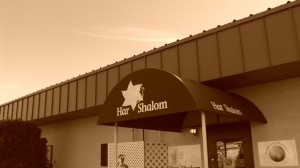
The entrance to the synagogue.
The Torah has been marched to the synagogue (a cross discovered in the building was similarly marched by church members to its building), the Eternal Light lit, services, Sunday school and Torah study are regular for the 60 family membership. The congregation did have a LA-URJ student from Los Angeles, but, says Chessin, “We severed relations with (them). We have our own rabbinic student who leads the services. Lilly Franklin is in the Jewish Renewal Aleph program. Some of it is online and conference calls training, but they gather several weeks each year for intense training.”
Chessin adds: “I meet people all the time who have someone Jewish in their background – a grandparent, sometimes a cousin, a parent, or the result of splitting and merging families – but few are affiliated or strongly identified with their Jewish past, and don’t really support or become members of the congregation. But that’s okay,” says former president Chessin. “Perhaps they will come at some point.”
Chessin’s father, now 93 and a retired professor of botany from U of M, was instrumental in the gatherings from the early 1950’s when a group of professors and town professionals established Har Shalom to start a Sunday school so their children would continue the heritage. The elder Chessin housed the congregation’s Torah, borrowed from a closed congregation in Helena for Bert’s bar mitzvah. It is now the current Torah.
“There is a Hillel at the university that gathers Friday night for Shabbos, but they come to Har Shalom for Rosh Hashanah and Purim – we have a big Purim party – and they have their own Sukkoth, and do their own Seder but they use our building,” says Bert. “It’s all part of the larger Jewish community.”
On the wall of the sanctuary is Deuteronomy Chapter 30, which is the final discourse Moses gave the people of Israel right before they entered Eretz Yisrael, the land of Israel. Har Shalom, Mountain of Peace, closing in on 65 families, continues to grow from strength to strength in Missoula, the Garden City of Montana. To contact the congregation, go to www.har-shalom.org.
Matthew J. Silver is a writer, reporter and researcher living in Indianapolis.
